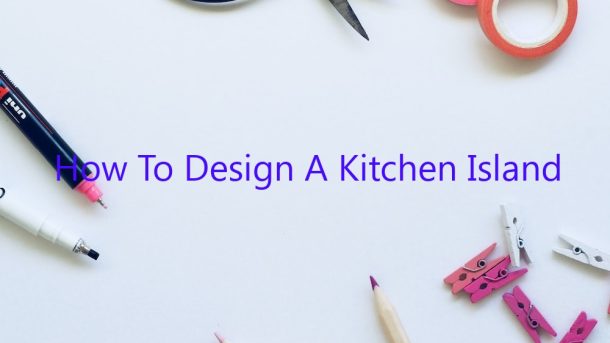A well-designed kitchen island can be the perfect focal point of a room. It can provide extra counter and storage space, and it can also make the room more functional and attractive. If you’re thinking about adding an island to your kitchen, here are a few tips to help you get started.
First, decide how big you want the island to be. Kitchen islands come in all shapes and sizes, so you can choose one that fits your specific needs. If you need extra counter space, you may want to choose a large island that has plenty of room for cooking and prep work. If you’re looking for a more decorative piece, you may want to go with a smaller island that has a more limited functionality.
Once you’ve decided on the size, it’s time to start thinking about the design. The most important thing to consider is how you’ll use the island. If you plan to use it as a workspace, you’ll need to make sure it has enough counter space and storage space. If you plan to use it as a dining area, you’ll need to make sure it has enough seating and that it’s the right height for eating.
You’ll also need to consider the island’s shape. Most islands are rectangular or square, but you can also find islands with more unique shapes. Consider how much space you have in your kitchen and what will look the best in the space.
Once you’ve decided on the size, shape, and functionality of the island, it’s time to start thinking about the details. You’ll need to choose a material for the island top, and you’ll also need to choose a color and style for the cabinets and other features. You can choose a traditional style or go with something more modern. You can also choose a light or dark color to match the rest of your kitchen.
Once you’ve decided on all of the details, it’s time to start building! Kitchen islands can be a DIY project, or you can hire a professional to do the job for you. If you’re feeling ambitious, you can even try building the island yourself. Just be sure to follow the instructions carefully and measure everything twice to ensure a perfect fit.
If you’re not interested in a DIY project, or if you don’t have the time or skills to build your own island, you can always hire a professional. There are a number of companies that specialize in kitchen island design and construction, so you can find one that fits your needs and budget.
No matter how you choose to design your kitchen island, it’s sure to be a popular and functional addition to your kitchen. So don’t wait any longer, start planning and designing your perfect island today!
Contents
How do you layout a kitchen island?
When it comes to kitchen islands, there are a lot of options to consider. But, before you can make any decisions, you need to first layout your kitchen island. This will help you determine the best size and shape for your island, as well as where it should go in your kitchen.
To layout your kitchen island, you’ll need to first measure the space you have available. Then, you’ll need to decide on the size and shape of your island. Once you have those figured out, you can start to design the island, choosing the right countertops, cabinets, and accessories.
When measuring for your kitchen island, make sure to account for the space you’ll need around the island for seating and appliances. You’ll also want to make sure there’s enough room for people to walk around the island.
The shape of your island is up to you, but there are a few things to keep in mind. If you have a lot of counter space, you may want to choose a large island with plenty of seating. If you have a small kitchen, a smaller island may be a better option. You also need to consider the flow of traffic in your kitchen. If the island is in the way, it may not be the best option.
Once you’ve chosen the size and shape of your island, it’s time to start designing it. The most important part of the design is the countertop. Make sure to choose a material that’s durable and easy to clean. You’ll also need to choose the right color and style to match your kitchen.
Next, choose the cabinets for your island. You’ll want to choose a style that matches your kitchen, and make sure to choose a color that will brighten up the space.
Finally, choose any accessories you want for your island. This could include a wine rack, a stove, or a sink.
Once you’ve layout your kitchen island, it’s time to start shopping for appliances and accessories. Be sure to choose the ones that will fit in your island’s space, and that will match the style of your kitchen.
What is the perfect kitchen island size?
When choosing a kitchen island size, it’s important to consider how you will use it. Will you need seating for dining? Will you need storage? Will you need counter space?
The most important dimension to consider is the width. The island should be at least as wide as the width of the cabinets that it will be sitting against. If the island is too narrow, it will be difficult to use.
The length of the island is also important. It should be long enough to accommodate the activities that you will be using it for. If you will be using it for dining, it should be at least as long as the table. If you will be using it for storage, it should be at least as long as the longest shelf.
The height of the island is also important. It should be high enough to accommodate the activities that you will be using it for. If you will be using it for dining, the height should be at least the height of the chairs. If you will be using it for storage, the height should be at least the height of the items that you will be storing.
Is it cheaper to buy or build a kitchen island?
kitchen islands are a popular addition to many kitchens. They provide extra counter space and storage, and can be a great place to eat or prepare food. There are two options when it comes to adding a kitchen island: you can buy one or build one. So, which is the cheaper option?
If you buy an island, you’ll likely pay anywhere from $200 to $2,000. The price will depend on the size and features of the island. If you build your own island, you can save money by using recycled materials or buying materials at a discount. However, you’ll also need to factor in the cost of labour. If you’re handy with a hammer and drill, you could build an island for around $100.
So, is it cheaper to buy or build a kitchen island? The answer depends on your budget and skills. If you’re on a tight budget, buying an island is the cheaper option. However, if you have some DIY skills, building your own island is the cheaper option in the long run.
Can you design your own kitchen island?
Designing your own kitchen island is a great way to get a kitchen that is perfect for your needs and style. There are a few things to consider before you get started, though.
First, decide what you want your island to do. Do you need extra counter space, storage, or a place to eat? Once you know what you need, you can start designing.
Think about the shape and size of your island. Will it fit in your kitchen? How big should it be?
Next, choose your materials. Islands can be made from a variety of materials, including wood, granite, and stainless steel. Choose the materials that will best fit your style and needs.
Finally, decide on the details. Do you want a sink or cooktop on your island? What about a built-in wine rack or dishwasher? The details can make your island really unique.
Once you have designed your island, it’s time to build it. Talk to a contractor about your plans and they can help you make your island a reality.
Should your kitchen island match your cabinets?
Many people believe that the kitchen island should match the cabinets in terms of style and color. This is not always the case, as there are a number of factors to consider when making this decision.
One of the most important things to consider is the function of the kitchen island. If you plan to use it as a workspace, it’s important that it has a surface that is large enough to accommodate your tasks. If you plan to use it as a storage area, you’ll want to make sure that it has enough space to store your supplies.
Another thing to consider is the layout of your kitchen. If your kitchen is small, you may want to choose a kitchen island that is small in size. If your kitchen is large, you may want to choose a kitchen island that is large in size.
The color and style of your kitchen island should also be considered. If you have a modern kitchen, you may want to choose a kitchen island that is modern in style. If you have a traditional kitchen, you may want to choose a kitchen island that is traditional in style.
It’s also important to consider the color of your cabinets. If you have light colored cabinets, you may want to choose a kitchen island that is light in color. If you have dark colored cabinets, you may want to choose a kitchen island that is dark in color.
Ultimately, the decision of whether or not to match your kitchen island to your cabinets depends on your individual needs and preferences. If you’re not sure what to do, it’s always best to consult a professional.
Which way should kitchen island face?
When planning your kitchen, one of the decisions you’ll need to make is what to do with your kitchen island. This piece of furniture can be a great addition to any kitchen, but you’ll need to choose the right spot for it. One thing to consider is the direction your kitchen island should face.
There are a few things to keep in mind when deciding which way your kitchen island should face. The first is the function of the island. If you plan to use it mostly for cooking, you’ll want it to face the stove. If you’ll be using it for storage or as a breakfast bar, you can place it anywhere you like.
Another thing to consider is the natural light in your kitchen. If you have a lot of windows, you may want to place the island so it faces the windows. This will allow you to take advantage of the natural light. If your kitchen is in a darker part of the house, you may want to place the island so it faces a light source.
It’s also important to consider the traffic flow in your kitchen. You don’t want the island to block the flow of traffic. If you have a lot of people in your kitchen, you may want to place the island in a spot where it won’t block the way.
Ultimately, the direction your kitchen island should face is up to you. It’s important to consider all of the factors involved before making a decision.
How far should a kitchen island be from the counter?
Kitchen islands are a popular addition to modern kitchens. They provide extra counter space and can also be used for storage. But one question that often arises is how far the island should be from the counter.
There is no definitive answer to this question, as it will depend on the layout of your kitchen and the size of your island. However, a good rule of thumb is to leave at least 36 inches between the island and the counter. This will provide enough space for people to move around comfortably.
If your kitchen is particularly small, you may want to consider leaving less space between the island and the counter. Conversely, if your kitchen is large, you may want to increase the distance to 48 or even 60 inches.
Ultimately, it is up to you to decide how much space you want between the island and the counter. Just make sure to keep in mind the comfort and convenience of your guests and family.




